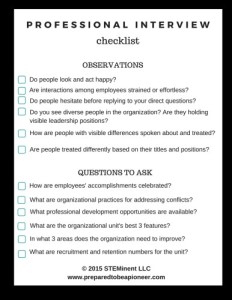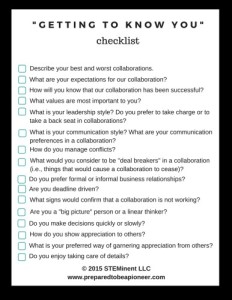Blog
Say “I Do” to Your Mentoring Dream Team
Mentoring is a big topic in the professional world. For years, people have identified mentoring as an option for retention of diverse populations in environments where people are underrepresented. Having someone to talk to and to receive feedback from can prove to be invaluable to trailblazers at every professional level. This is demonstrated in a variety of mentoring tips and initiatives, especially those targeting people in science, technology, engineering, or mathematics (STEM).
With emphases on mentoring across a variety of occupational sectors, I dug deeper into my own mentoring thoughts and experiences. What do I wish that I had known before I began my academic career? In what ways might I guide others interested in identifying an effective mentor or serving as a mentor? I propose that we look to the most loving and cohesive relationship of all as a point of guidance in professional mentoring- marriage. Read more about my “Something Old, Something New, Something Borrowed, and Something Blue” (ONBB) mentoring model below.
Something Old
Representing the traditional model of mentoring, the Old mentoring component connects a mentee to mentors who know the game and how to play it. It is vital for mentees to connect to these experts who possess organizational knowledge and credibility in their fields. These mentors are great at introducing mentees to cultural and professional norms and to ways of doing business so that feathers are not ruffled. In my case, Old mentors are seasoned faculty who have gone through the promotion and tenure process at my university. Since I am an engineering professor, many of my Old mentors are male engineers who are well-received in their professions and are leaders of professional and organizational disciplinary societies or large-scale research centers.
How to Identify Your Old Mentors: Look for the “go-to” people and the people who possess organizational knowledge and respect. These are the people who lead initiatives in your field. Your goal is to connect to them so you can enter those doors as well.
Something New
The New mentoring component engages mentees with “out of the box” people who are experts in areas that are outside of your field. People like this may not be well-known in your profession but are widely recognized experts in their own organizational circles. For me, this mentoring occurred when I engaged with my friend and colleague, David Brim. David is a social marketing guru who created my personal website (Prepared to Be a Pioneer website), my research website (International Institute for Engineering Education (i2e2a)), and the site for an educational assessment tool that I am commercializing. With his team of creatives, I have transformed my thinking so that I consider both marketing and my engineering education content in my professional endeavors.
How to Identify Your New Mentors: You will have to move out of your traditional circles to find these mentors. They are people who are extremely innovative and do things in ways that appeal to you although you may not know exactly how to connect to them initially. Because they are creative, once you partner with them, you will identify unique synergies. (I’ll warn you now that they will move you out of your comfort zone!)
Something Borrowed
Borrowed mentors are somewhat similar to New mentors. They differ, however, in that there is some professional overlap between what they do and what you do. Their interdisciplinary perspectives allow you to expand your network to people who might work in multiple domains of expertise moreso than a single field. When you meet these mentors, it may take longer for them to recognize how your interest align, and they may not yet who you are or what you have to offer them. For me, this was demonstrated with my engagement with a colleague interested in professional and personal interactions among individuals. His interest from a business perspective, coupled with my expertise in professional development for academics, resulted in my co-leadership and cosultation on a social networking mobile application.
How to Identify Borrowed Mentors: These mentors are often found through common connections- people who know you and know your potential mentor. Research your current networks to identify potential connections to people with common interests in multiple occupational sectors.
Something Blue
Blue mentors are also what I call “Bad Day Buddies.” These mentors may have no knowledge of your professional work or expertise, but they know YOU. They know how to listen to you and to respond to you based on your unique personality and preferences. They don’t condemn you for being real or honest, and they are not jealous of your successes. My Blue mentors are people in my inner circle. I have a couple of female faculty of color in my life with whom I express my frustrations and most intimate professional views. I know that they will not betray my trust and will give me advice that I don’t always want to hear but need to hear.
How to Identify Blue Mentors: There is no formula for finding these mentors. When you have a Blue mentor, you know it. This type of mentorship occurs organically and often among peers.
Are you still wondering where to start in your identification of your Old, New, Borrowed, and Blue Mentors? Add your name to my contact list, and I’ll provide guidance as you look for them!
Something Old
Representing the traditional model of mentoring, the Old mentoring component connects a mentee to mentors who know the game and how to play it. It is vital for mentees to connect to these experts who possess organizational knowledge and credibility in their fields. These mentors are great at introducing mentees to cultural and professional norms and to ways of doing business so that feathers are not ruffled. In my case, Old mentors are seasoned faculty who have gone through the promotion and tenure process at my university. Since I am an engineering professor, many of my Old mentors are male engineers who are well-received in their professions and are leaders of professional and organizational disciplinary societies or large-scale research centers.
How to Identify Old Mentors: Look for the “go-to” people and the people who possess organizational knowledge and respect. These are the people who lead initiatives in your field. Your goal is to connect to them so you can enter those doors as well.
Something New
The New mentoring component engages mentees with “out of the box” people who move beyond traditional boundaries within a field. People like this may not be well-known in your profession but are experts in their own organizational circles. For me, this mentoring occurred when I engaged with my friend and colleague, David Brim. David is a social marketing guru who created my Prepared to Be a Pioneer website, my International Institute for Engineering Education (i2e2a) research page, and the site for an educational assessment tool that I am commercializing. With his team of creatives, I have transformed my thinking so I consider both marketing and my engineering education content in my endeavors.
How to Identify New Mentors: You will have to move out of your traditional circles to find these mentors. They are people who are extremely innovative and do things in ways that appeal to you although you may not know exactly how to connect to them initially. Because they are creative, once you partner with them, they will note unique synergies. (I’ll warn you now that they will move you out of your comfort zone!)
Something Borrowed
Borrowed mentors are somewhat similar to New mentors. They differ, however, in that there is some professional overlap in what they do with what you do. They are beneficial when you are trying to expand your network to people who might benefit from your professional expertise but don’t yet know who you are or what you have to offer them. For me, this is demonstrated with my engagement with a colleague interested in professional and personal interactions among individuals. His interest from a business perspective, coupled with my expertise in professional development for academics, has resulted in a soon-to-be launched product that has the potential to revolutionize interactions among diverse stakeholders.
How to Identify Borrowed Mentors: These mentors are often found through common connections- people who know you and know your potential mentor. Research your current networks to identify potential connectors to people with common interests in other occupational sectors.
Something Blue
Blue mentors are also what I call “Bad Day Buddies.” These mentors may have no knowledge of your professional work or expertise, but they know YOU. They know how to listen to you and respond to you based on your unique personality and preferences. They don’t condemn you for being real or honest, and they are not jealous of your successes. My Blue mentors are people in my inner circle. I have a couple of female faculty of color in my life with whom I express my frustrations and most intimate professional views. I know that they will not betray my trust and will give me advice that I don’t always want to hear but need to here.
How to Identify Blue Mentors: There is no formula for finding these mentors. When you have a Blue mentor, you just know it. These mentors are often found organically and can be peer mentors as well.
UPDATE and BONUS:
I have created a FREE 2 page ONBB Mentoring Worksheet for my readers who want to engage in an exercise to find their dream team. Check it out, and let me know what you think about it!
———-
If you enjoyed my post, feel free to share it with others. Also check out my other blog posts, and provide your contact information so that we can stay connected. Like me on Facebook, and follow me on Twitter, Instagram, and Pinterest.
Pioneer Tip: Don’t Blame Yourself When a Misunderstanding Occurs
Have you ever had a misunderstanding with someone? I recently had an opportunity to reflect on my personal and professional life and misunderstandings that I have encountered in a variety of situations. Despite these misunderstandings, in 2014, I made life-changing decisions about being authentic and about not internalizing issues that have stressed me out in the past. Among these issues included feeling that I was a member of the “out group” among some members of my family (a childhood issue that I decided to confront as an adult), having limited access to important information and to access in a work environment, and being isolated in some environments because I expressed views that diverged from the norm.
Holding true to my values has not been easy. I have been threatened by a student who was not pleased with my administrative decisions. I have been excluded from meetings in the workplace by an individual who held a position of power and did not want me to challenge her position and views. I have been confronted on my job by a wife who was upset at how I engaged with her husband at a conference. I have even been cursed out by a relative who became upset when I posted my thoughts on social media about a ridiculous family situation. Looking back, I have no regrets for the decisions that I have made in any of these situations. Each of these individuals chose to express themselves as they did, and I too, have chosen to express my prerogative in authentic ways that let others know that despite the degrees, titles, and awards I possess, I am a human who sometimes faces real challenges in life.
One of the ways that I address challenges, however, is to share my thoughts and perspectives about staying sane in spite of drama and conflicts. Many of these conflicts arise because of misunderstandings and miscommunication. Although you can’t control their thoughts and actions, you can prepare for potential conflicts that may come your way.
Below are some of the most common ways that people might misunderstand you.
(1) People assume that you are something that you are not.
One of my common experiences is being perceived as snobby or unapproachable. Some of this comes from the fact that I don’t like to waste my time, a precious commodity that cannot be bought or restored once it is lost. I AM selective about with whom I engage. I am not, however, someone who does not assist people who need help. I came to the conclusion that people who need to know me will know me and those who don’t want to get to know me can stay in my outer circle and make their assumptions about who I really am.
Reflection: If you think that people are making assumptions about you, determine whether you really care about changing these assumptions. If you do care, identify ways that you might present information about who you really are across multiple channels. If you don’t care, keep moving!
(2) People are afraid of conflict and/or the unknown.
I experienced a workplace conflict several months ago. The funniest aspect of this ordeal was that people were talking to each other about the conflict but would not talk to me directly about the incident and my interpretation of it. To this day, I am not sure why people were afraid to talk to me. Did they think that I would curse them out or bite their heads off? My point is that these misunderstandings occurred because people would not address the heart of the issue and would not ask me questions that might clarify their concerns.
Reflection: Decide if it is worth addressing the misunderstanding. If the people who are engaged in the conflict are people with whom you do not care to have long-lasting relationships, keep moving!
(3) People do not want to change.
I am not a traditional person. During my professional life, however, I have worked in mostly traditional environments. I know that when I start a project or work with people, I’m going to be an “out of the box” thinker. I want to find creative ways to connect thoughts and people. I want to push existing boundaries in an effort to create new solutions to old problems. As a result, when some people see me coming, they go the other way. They don’t understand that I want to be a member of the team and that I might want my unique voice to be heard.
Reflection: You are who you are, and people who are who they are. If you find yourself in environments that do not align with your values and beliefs, it might be time to keep moving!
If you do all that you do to represent who you are, and people still don’t understand you, remember that it is their problem, not yours.
———-
If you enjoyed my post, feel free to share it with others. Also check out my other blog posts, and provide your contact information so that we can stay connected. Like me on Facebook, and follow me on Twitter, Instagram, and Pinterest.
What No One Tells You about Being the First Professor in Your Family
When I travel to my relatives’ homes Alabama, it’s as if I have gone underground. Depending on where I am, I cannot use my telephone or obtain wireless access. Although I have hotspot capabilities on my cell phone, the phone won’t work if I have no signal. Forget about using a Nook app, watching a movie on Netflix, or connecting to a Virtual Private Network at my university. If what I need isn’t available in the house and communities where I am at that moment, I’m in trouble. Panera and Starbucks become my best friend, because I have to strategically find free wi-fi in nearby cities to connect to people in the outside world.
As an Associate Professor, it’s difficult to explain how I can go from working 12 hours a day in my home environment to checking in for maybe an hour on a given day when I am out of town in remote areas. Many of my minority professor friends mention that when they leave their home offices and situations, they are limited by the resources available to them among family members. In addition, since my family and in-laws don’t live in major cities, traveling to these cities requires either driving 11-13 hours one way or paying up to $1000 per ticket so that my husband and I can fly directly into cities closest to where our families live.
My point is not to complain about the lack of resources available at the homes of my family members but to inform the world of another type of diversity- one where people who grew up in rural areas or are the first to enter a field that requires advanced resources are expected to work at high levels of proficiency all the time. To maintain their jobs, they have to “be on” and not use their families’ environments as excuses, especially in jobs where they may already be marginalized.
These professionals often live in two worlds- one where they are “on call” and responsive to everyone’s needs and another where they must adjust to the stark realities of environments where technology is not the top priority. These cultural gaps need to be addressed in higher education, especially if we want to attract more students and faculty to science, technology, engineering, and mathematics (STEM). (As far as I know), it’s not acceptable to say that you miss details, e-mails, or meetings because you are in a location that doesn’t have the resources that you need to complete your assignments.
As I sit in Panera writing this and wondering if I’m going to have to eat 3 bagels in exchange for the access to resources that I am using, I encourage higher education professionals to consider the fact that many people are experiencing situations behind the scenes that may seem minor but are very real in the United States. It’s time to support professionals in new ways so that they don’t have to choose between being a model professional or a great family member.
——————-
If you enjoyed my post, feel free to share it with others. Also check out my other blog posts, and provide your contact information so that we can stay connected. Like me on Facebook, and follow me on Twitter, Instagram, and Pinterest.
3 Common Sense Tips to Recruit and Retain Faculty of Color
Last year, I served on a panel sponsored by Diverse: Issues in Higher Education at the Annual Meeting of the Association of American Colleges and Universities in Washington DC to discuss best practices for minority faculty recruitment and retention in the academy. An issue of concern raised by many attendees, particularly those interested in recruiting underrepresented minorities at their institutions, was how to connect and engage with faculty of color at all ranks. With women of color professionals in academia often being mistaken for custodial workers and with many people of color choosing not to pursue academic careers or leaving science, technology, engineering, or mathematics (STEM) fields after earning Ph.D.s, concerns about recruitment and retention of faculty of color are real.
Via the panel, reflections, interactions, and conversations with numerous stakeholders, I decided to provide a few suggestions to inform potential interactions between majority and minority faculty in the academy. Although many such conversations may never occur openly, I hope that my perspective will offer new suggestions for engagement with current and future faculty of color.

(1) Listen.
Although this sounds like a no-brainer, many people don’t take the time to shut their mouths and to listen to the (honest) perspectives of others. Since we all represent diverse backgrounds and viewpoints, it is vital to listen actively to what others have to say, even when the conversations are uncomfortable or difficult.
Proactivity Tip: If you are leading a meeting or committee, allow all voices to be heard. Although it takes practice, listening actively and responding sensitively to what has been said will open you and your organization to new perspectives. If you allow a minority voice to receive as much attention as a majority voice, you are on your way to promoting inclusivity.
(2) Assume the best, not the worst.
In the same way that minority professionals are often mistaken for custodial workers, other assumptions are also often made about their titles, credentials, etc. Examples include calling a minority faculty member with a doctorate “Mr.” or “Mrs.” instead of “Professor” or “Dr.” Although many individuals mean no harm when they engage with minority faculty casually, the sum of many negative experiences in which minorities are not respected may lead to misunderstandings within your exchanges.
Proactivity Tip: Think about how you would want to be treated when deciding how to engage with faculty of color, and make sure that you are implementing the golden rule. Also reflect on ways that you automatically receive respect from students and colleagues (e.g., being included in decision-making meetings or having access to resources that are not offered to everyone), and use any privileges that you have to include people of color in a culture’s inner circle. Remember, in the end, the entire team wins!
(3) Develop thick skin.
When you open yourself up to the perceptions that POC have about an environment, you must be thick-skinned. This means that you may hear a viewpoint that conflicts with your own. To promote changes, however, such honesty is needed within an environment.
Proactivity Tip: Engage with facilitators and tools that promote open discussion among majority and minority faculty. You may contact someone in your Human Resources department, a private consulting firm, or a consultant (see my services)to discuss ways to facilitate this conversation and to ensure that no personal or professional boundaries are crossed during exchanges. The leader must be vulnerable and humble enough to admit that he/she is open to feedback that will make an environment a better place for everyone.
In conclusion, these three tips are only a few that might remove any barriers that faculty of color are or will experience in your organization. Even if your organization has a history of negativity among faculty of color, celebrate the fact that you are making positive strides toward making it a better place for all.
BONUS: Download this FREE guide for faculty who want insider tips about what to look for and ask in a job interview!
——————-
If you enjoyed my post, feel free to share it with others. Also check out my other blog posts, and provide your contact information so that we can stay connected. Like me on Facebook, and follow me on Twitter, Instagram, and Pinterest.
The Ultimate Cheat Sheet on Being a Good Team Leader and Member
In a world where people are rewarded for being unique and for standing out in a crowd, being a good team member isn’t always recognized or rewarded. Although people possess differing views about what it means to be a great team member, I’m offering a few tips based upon my experiences as professor and entrepreneur. Although it’s still possible for people to misunderstand your intentions, thinking about your role on a team at the early stages of team formation demonstrates your proactivity and your commitment to the team and its success.
When making decisions, think first about what’s best for the team.
Although it may seem that you are getting the bad end of a deal by placing your team’s needs and considerations before your needs, a good leader always considers the team during decision making. By identifying what is in the best interest of your team, your team members will trust you as their leader and as someone who has their back.
Communicate changes to the team BEFORE disclosing changes to members outside of your team.
This comes back to an issue of trust. There is nothing like being on a team and then finding out information about what is occurring in your organization from someone who is outside of your organization. If this happens and you are the leader, quickly apologize to your team members and identify new ways to enhance internal efforts. If you are a member of the team, determine whether you team leader is receptive to feedback. If you know that you will be persecuted for addressing the issue, determine whether it is worth confronting your leader.
Overcommunicate.
Miscommunication is a big problem on teams. Since many people often enter a team with preconceptions and misconceptions, team members must make sure that they use multiple forms of communication (e.g., verbal and written) to establish group norms and to confirm that everyone is on the same page.
Acknowledge your limitations and weaknesses.
Although acknowledging one’s weaknesses makes a person vulnerable, this level of vulnerability provides a foundation of trust for all team members. Through this professional “nakedness,” members can begin to grow as a team and can identify ways to minimize individual weakness by drawing upon all team members’ personal and professional strengths.
Identify and use professional development tools that will improve your leadership.
Although there are numerous on-line and hard copy tools available to assess one’s leadership and team member skills, one of the best assessment practices is to engage in 360 degree assessments. Such assessments allow all members of a team to offer feedback about their experiences and perspectives. In addition, consider selecting personality or work style assessments that provide individual feedback about team members’ preferences and traits. Debrief results with all team members to determine the best way for team members to move ahead to achieve team goals.
Listen to other team members’ perspectives about areas in which you need to improve.
Once you have completed assessments, engage in “real talk” with team members about areas of strength and weakness. This requires a leader to create an atmosphere in which people can communicate openly. Although it may be difficult to listen to initial feedback, hearing the perspectives of ALL team members is vital to fostering a positive workplace culture. A helpful tip for me is to always remember to separate the personal from the professional (e.g., You can like a person but disagree with her idea and vice versa.)
Allow other team members to do their jobs.
Once you have set all tools in place, give every team member the freedom to create and (yes!) fail. Through this autonomy, the team can observe how team members handle stress and request assistance when they need it. One of the biggest challenges for those of us who like to be in control is to trust others and to delegate. Doing this, however, ensures that team morale remains high and that people feel empowered in their jobs.
In conclusion, being a team member is not always easy. Like any relationship, however, members must take into consideration the perspectives and contributions of others so that everyone wins in the end.
BONUS: I’ve created a FREE downloadable collaborator checklist for you to use before you engage in a new partnership! I guarantee that these questions will help you start your collaboration off in the right way.
——————-
If you enjoyed my post, feel free to share it with others. Also check out my other blog posts, and provide your contact information so that we can stay connected. Like me on Facebook, and follow me on Twitter, Instagram, and Pinterest.






